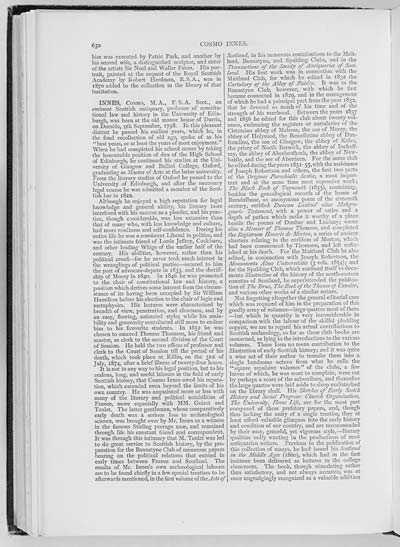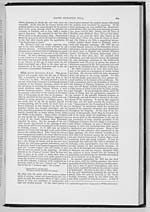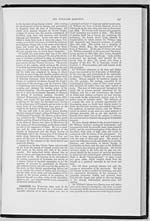Volume 3 > Half-Volume 6
(276) Page 630 - Innes, Cosmo
Download files
Individual page:
Thumbnail gallery: Grid view | List view

630 him was executed by Patric Park, and another by his second wife, a distinguished sculptor, and sister of the artists Sir Noel and Waller Paton. His por- trait, painted at the request of the Royal Scottish Academy by Robert Herdman, R.S.A., was in 1870 added to the collection in the library of that institution. INNES, COSMO, M.A., F. S.A. Scot., an eminent Scottish antiquary, professor of constitu- tional law and history in the University of Edin- burgh, was born at the old manor house of Durris, on Deeside, 9th September, 1798. In this pleasant district he passed his earliest years, which he, in the fond recollection of old age, spoke of as his "best years, or at least the years of most enjoyment." When he had completed his school career by taking the honourable position of dux of the High School of Edinburgh, he continued his studies at the Uni- versity of Glasgow and Balliol College, Oxford, graduating as Master of Arts at the latter university. From the literary studies of Oxford he passed to the University of Edinburgh, and after the necessary legal course he was admitted a member of the Scot- tish bar in 1822. Although he enjoyed a high reputation for legal knowledge and general ability, his literary taste interfered with his success as a pleader, and his prac- tice, though considerable, was less extensive than that of many who, with less knowledge and culture, had more readiness and self-confidence. During his entire life he was a consistent Liberal in politics, and was the intimate friend of Lords Jeffrey, Cockburn, and other leading Whigs of the earlier half of the century. His abilities, however, rather than his political creed�for he never took much interest in the wranglings of political parties�secured to him the post of advocate-depute in 1833, and the sheriff- ship of Moray in 1840. In 1846 he was promoted to the chair of constitutional law and history, a position which derives some interest from the circum- stance of its having been occupied by Sir William Hamilton before his election to the chair of logic and metaphysics. His lectures were characterized by breadth of view, penetration, and clearness, and by an easy, flowing, animated style; while his amia- bility and generosity contributed still more to endear him to his favourite students. In 1852 he was chosen to succeed Thomas Thomson, his friend and master, as clerk to the second division of the Court of Session. He held the two offices of professor and clerk to the Court of Session till the period of his death, which took place at Killin, on the 31st of July, 1874, after a brief illness of twenty-four hours. It is not in any way to his legal position, but to his zealous, long, and useful labours in the field of early Scottish history, that Cosmo Innes owed his reputa- tion, which extended even beyond the limits of his own country. He was acquainted more or less with many of the literary and political notabilities of France, more especially with MM. Guizot and Teulet. The latter gentleman, whose comparatively early death was a serious loss to arch�ological science, was brought over by Mr. Innes as a witness in the famous Stirling peerage case, and remained through life his constant friend and correspondent. It was through this intimacy that M. Teulet was led to do great service to Scottish history, by the pre- paration for the Bannatyne Club of numerous papers bearing on the political relations that existed in early times between France and Scotland. The results of Mr. Innes's own archaeological labours are to be found chiefly in a few special treatises to be afterwards mentioned, in the first volume of the Acts of Scotland, in his numerous contributions to the Mait- land, Bannatyne, and Spalding Clubs, and in the Transactions of the Society of Antiquaries of Scot- land. His first work was in connection with the Maitland Club, for which he edited in 1832 the Cartulary of the Abbey of Paisley. It was to the Bannatyne Club, however, with which he first became connected in 1829, and in the management of which he had a principal part from the year 1832, that he devoted so much of his time and of the strength of his manhood. Between the years 1837 and 1856 he edited for this club about twenty vol- umes, embracing the registers or cartularies of the Cistercian abbey of Melrose, the see of Moray, the abbey of Holyrood, the Benedictine abbey of Dun- fermline, the see of Glasgow, the abbey of Kelso, the priory of North Berwick, the abbey of Inchaff- ray, the abbey of Aberbrothock, the abbey of New- battle, and the see of Aberdeen. For the same club he edited during the years 1851-55, with the assistance of Joseph Robertson and others, the first two parts of the Origines Parochiales Scotia:, a most impor- tant and at the same time most expensive work; The Black Book of Taymouth (1855), containing, besides the genealogical records of the house of Breadalbane, an anonymous poem of the sixteenth century, entitled Duncan Laideus' alias aMakgre- gouris Testament, with a power of satire and a depth of pathos which make it worthy of a place beside the poems of Dunbar and Lindsay; wrote also a Memoir of Thomas Thomson, and completed the Registrum Honoris de Morton, a series of ancient charters relating to the earldom of Morton, which had been commenced by Thomson, and left unfin- ished at his death. For the Maitland Club he also edited, in conjunction with Joseph Robertson, the Monumenta Alme Universitatis (3 vols. 1854); and for the Spalding Club, which confined itself to docu- ments illustrative of the history of the north-eastern counties of Scotland, he superintended the publica- tion of The Brus, The Book of the Thanes of Cawdor, and various other works of a similar nature. Not forgetting altogether the general editorial care which was required of him in the preparation of this goodly array of volumes�large quartos most of them �but which in quantity is very inconsiderable in comparison with the labour of the skilful plodding copyist, we are to regard his actual contributions to Scottish archaeology, so far as these club books are concerned, as lying in the introductions to the various volumes. These form no mean contribution to the illustration of early Scottish history; and it was quite a wise act of their author to transfer them into a single handsome octavo from what he calls the "square repulsive volumes" of the clubs, a few leaves of which, he was wont to complain, were cut by perhaps a score of the subscribers, and thereafter the large quartos were laid aside to sleep undisturbed on the library shelf. His Sketches of Early Scotch History and Social Progress: Church Organization, The University, Home Life, are for the most part composed of these prefatory papers, and, though thus lacking the unity of a single treatise, they at least afford valuable glimpses into the early history and condition of our country, and are recommended by their easy, graceful, yet vigorous style,�literary qualities sadly wanting in the productions of most antiquarian writers. Previous to the publication of this collection of essays, he had' issued his Scotland in the Middle Ages (1860), which had in the first instance been delivered as lectures in the college class-room. The book, though stimulating rather than satisfactory, and not always accurate, was at once ungrudgingly recognized as a valuable addition
Set display mode to:
![]() Universal Viewer |
Universal Viewer | ![]() Mirador |
Large image | Transcription
Mirador |
Large image | Transcription
Images and transcriptions on this page, including medium image downloads, may be used under the Creative Commons Attribution 4.0 International Licence unless otherwise stated. ![]()
| Biographical dictionary of eminent Scotsmen > Volume 3 > Half-Volume 6 > (276) Page 630 - Innes, Cosmo |
|---|
| Permanent URL | https://digital.nls.uk/74514826 |
|---|---|
| Attribution and copyright: |
|
| Description | Volume III. Contains names alphabetically from Macadam to Young. |
|---|

